Vaporizing
 Vaporizing is a common smokeless alternative to consuming or smoking marijuana that allows marijuana smokers to inhale many active cannabinoids, while avoiding the harmful elements that may be inhaled when smoked.
Vaporizing is a common smokeless alternative to consuming or smoking marijuana that allows marijuana smokers to inhale many active cannabinoids, while avoiding the harmful elements that may be inhaled when smoked.
Vaporizers work by heating marijuana at a temperature just below its combustion point of 392°F, producing an inhalable vapour that still contains the active medical ingredients in marijuana (cannabinoids), but without the harmful by-products.
When you smoke marijuana, approximately 88% of the combusted smoke gases contain non-cannabinoid elements, most of which do not get you high and provide health risks. However, when using a vaporizer the smoke/gases that are inhaled consist of approximately 95% cannabinoids, the sought after psychoactive ingredients. Studies have shown that vaporizers can convert 46% of available THC into vapour, compared to only 25% of THC when smoking a joint or bong.
Not only are vaporizers better for your health but they are much more discreet in public. With no odour, and hardly any smoke, they provide you with complete stealth and discretion. Vaporizing is also cost efficient, as many patients are able to reduce their dose by 30 – 50%. Another benefit is the early onset of effect, around 30-60 seconds.
Vaping temperatures depend on your personal preference and the kind of vaporizer you are using. Different temperatures release different cannabis compounds that can give you a range of effects. For example, 185°C is an ideal temperature to release the most psychoactive compounds. Temperatures below 190°C produce a more cerebral high, while temperatures above 190°C tend to give you a body high.

Δ9-Tetrahydrocannabinol (THC)
Boiling point: 157°C / 314.6°F
Properties: Euphoriant, Analgesic, Anti-inflammatory, Antioxidant, Antiemetic |
Cannabidiol (CBD)
Boiling point: 160-180°C / 320-356°F
Properties: Anxiolytic, Analgesic, Antipsychotic, Anti-inflammatory, Antioxidant, Antispasmodic |
Cannabinol (CBN)
Boiling point: 185°C / 365°F
Properties: Oxidation, Breakdown, Product, Sedative, Antibiotic |
Cannabichromene (CBC)
Boiling point: 220°C / 428° F
Properties: Anti-inflammatory, Antibiotic, Antifungal |
Δ8- Tetrahydrocannabinol (Δ8-THC)
Boiling point: 175 – 178°C / 347 – 352.4°F
Properties: Resembles Δ9 – THC, less psychoactive, more stable antiemetic |
Tetrahydrocannabivarin (THCV)
Boiling point: <220°C / <428°F
Properties: Analgesic, Euphoriant |
There are three kinds of vaporizers that heat the marijuana in different ways. Some vaporizers may also use a combination of heating methods.
To purchase a vaporizer click here.
Edibles
 For cannabis to be effective in edible products, it is important to understand the process of decarboxylation.
For cannabis to be effective in edible products, it is important to understand the process of decarboxylation.
Decarboxylation
Raw cannabis contains a lot of THCA, which has anti-inflammatory and neuroprotective effects, although it does not produce the psychoactive effect that makes you feel high. However, thanks to the process of decarboxylation, THCA is converted into THC.
Decarboxylation or decarbing refers to the chemical reaction that removes a carbon atom from a carbon chain, releasing carbon dioxide (CO2). This process converts THCA to THC, the compound with many medical and psychoactive effects.
When you smoke or vaporize, the cannabis is decarbed by the heat. If you ingest cannabis and want the full psychoactive effect, you need to first decarb your cannabis before you cook with it. You can do this in many different ways, such as baking your cannabis, a hot oil bath, or a hot water bath.
Decarboxylation Methods:
Oven:
When it comes to baking your cannabis, you must be very accurate with your temperatures and careful as to not under or over bake it. Keep in mind that the lower the temperature, the longer it is going to take your cannabis to decarb. However, lower temperatures will allow you to lose fewer terpenes.

Note: Grind your flower/leaves first – a course grind will allow plant material to evenly dry without losing potency from over grinding.
- Preheat your oven (See table below). Use an oven thermometer to check the temperature.
- Sprinkle your cannabis in an oven safe dish and then cover it well with silver foil by crimping the foil along the edge of the plate.
- Place in the oven – less time for older drier material, more for fresher material.
- After required time, turn the oven off, and remove cannabis. Let it cool down slowly before you unseal the container to allow any cannabinoid/terpenes vapor to reabsorb into the cannabis.
Boiling Bag method:

- Place the cannabis flower into a boilable cooking pouch. Seal it. (See below for temperature)
- Place in boiling water for 90 minutes. Make sure water does not boil dry.
- Take bag out of water. Let it slowly cool before opening.
| Temperature | Heating Method | Time for Plant Material |
| 240°F | Oven | 30 - 45 Minutes |
| 310°F | Oven | 10 - 18 Minutes |
| 212°F | Boiling Water Bath | 90 Minutes |
Edibles are cannabis infused food products such as cookies, brownies, oils and butters. They are a great alternative if you suffer from a compromised respiratory system, don’t feel comfortable smoking or vaporizing and for patients who require a long lasting, steady high.
When cooking or baking with marijuana it is important that you know the dose you are taking as the effects of edibles have double the potency and the high can last much longer than smoking it. Keep in mind that the effects can take anywhere from 30 minutes to 2 hours to begin, so if nothing happens for a while, don’t get impatient and eat more. As many people have different tolerances to the amount of cannabis they can ingest, we recommend starting with a low dose and increasing the dosage the next time until you are happy with the high.
It is important to use fat (oil, butter, milk, etc) when cooking with cannabis because
THC is fat-soluble, meaning they bond best with substances containing high levels of fat and without any fat content; it is impossible to get high. The most popular way to use fat when cooking with cannabis is to use cannabutter used as a replacement for standard butter. However, butter is probably not the healthiest way for a patient to medicate on a daily basis. Instead, you can use plant-based fats, like olive, canola, or coconut oil, which is also a great option for vegans and dairy sensitive patients.
For recipes click here.
Tinctures
 Tinctures are essentially alcohol extractions of whole cannabis, that are easy to make and very inexpensive. They also contain all 80 of the essential cannabinoids. Some of the cannabinoids such as cannibidiol (CBD) actually reduce the psychoactive effects of THC while increasing the overall efficacy of the preparation.
Tinctures are essentially alcohol extractions of whole cannabis, that are easy to make and very inexpensive. They also contain all 80 of the essential cannabinoids. Some of the cannabinoids such as cannibidiol (CBD) actually reduce the psychoactive effects of THC while increasing the overall efficacy of the preparation.
The most common way to use tinctures is sublingually (under the tongue). Dose control is easily achieved by the number of drops a patient places under the tongue where the medicine is rapidly absorbed into the arterial system and is quickly transported to the brain and body. All a patient needs do with a tincture is use a few drops, wait for the desired medical effects, and either use more or stop as the situation indicates.
Tinctures can be flavored for better taste. They are best stored in dark bottles in the refrigerator. Since tinctures average some 75% ethanol there is little worry of bacterial or other biological contamination.
You can also add your tincture to a cup of tea or juice for easy delivery. However when a tincture is used in a beverage, absorption will be slower than if absorbed under the tongue.
Click here for instructions on how to make tinctures.
 Vaporizing is a common smokeless alternative to consuming or smoking marijuana that allows marijuana smokers to inhale many active cannabinoids, while avoiding the harmful elements that may be inhaled when smoked.
Vaporizing is a common smokeless alternative to consuming or smoking marijuana that allows marijuana smokers to inhale many active cannabinoids, while avoiding the harmful elements that may be inhaled when smoked.








